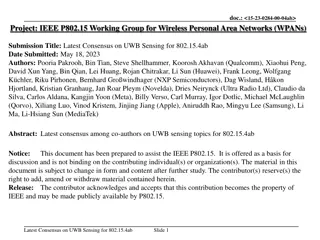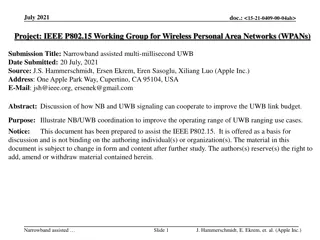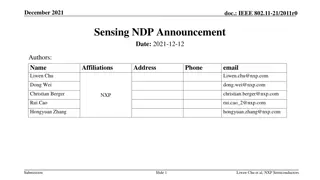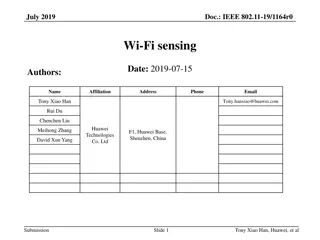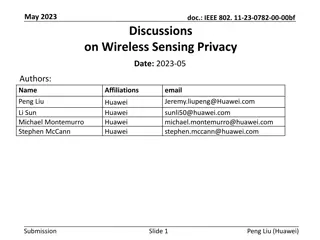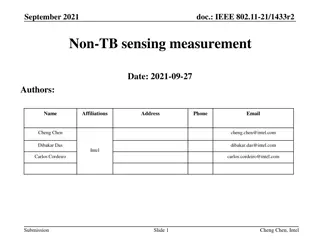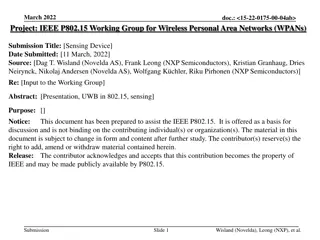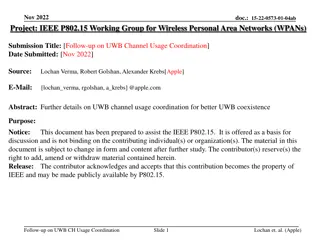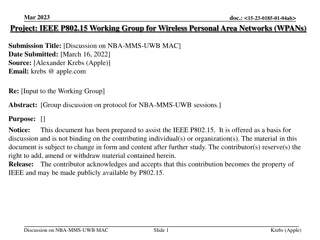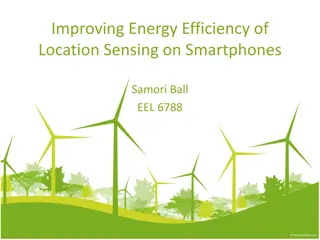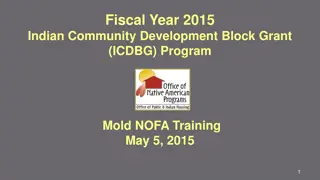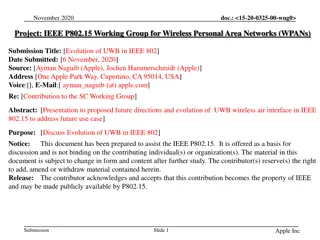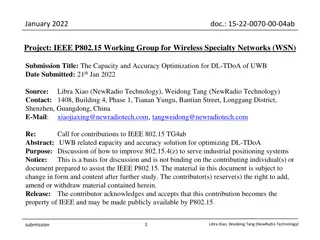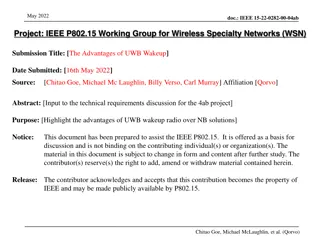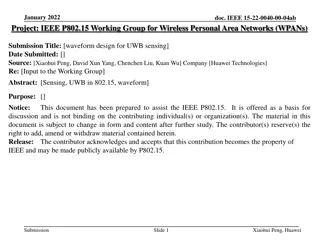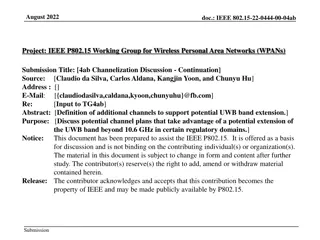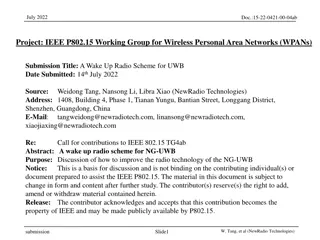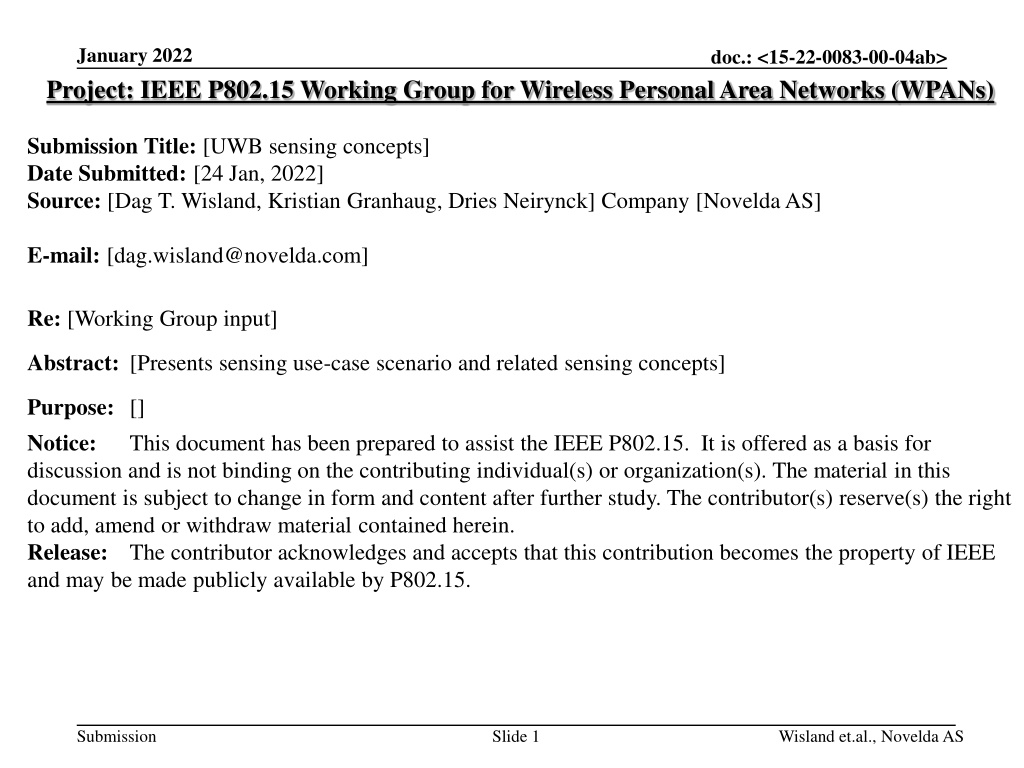
IEEE P802.15 Working Group UWB Sensing Concepts
"Explore UWB sensing concepts in the IEEE P802.15 Working Group document focused on wireless personal area networks. The submission discusses sensing use-case scenarios, interference mitigation techniques, accuracy improvements, and more for high-integrity ranging and efficient collaboration over multiple sensing-capable nodes."
Download Presentation

Please find below an Image/Link to download the presentation.
The content on the website is provided AS IS for your information and personal use only. It may not be sold, licensed, or shared on other websites without obtaining consent from the author. If you encounter any issues during the download, it is possible that the publisher has removed the file from their server.
You are allowed to download the files provided on this website for personal or commercial use, subject to the condition that they are used lawfully. All files are the property of their respective owners.
The content on the website is provided AS IS for your information and personal use only. It may not be sold, licensed, or shared on other websites without obtaining consent from the author.
E N D
Presentation Transcript
January 2022 Project: IEEE P802.15 Working Group for Wireless Personal Area Networks (WPANs) doc.: <15-22-0083-00-04ab> Submission Title: [UWB sensing concepts] Date Submitted: [24 Jan, 2022] Source: [Dag T. Wisland, Kristian Granhaug, Dries Neirynck] Company [Novelda AS] E-mail: [dag.wisland@novelda.com] Re: [Working Group input] Abstract: [Presents sensing use-case scenario and related sensing concepts] Purpose: [] Notice: discussion and is not binding on the contributing individual(s) or organization(s). The material in this document is subject to change in form and content after further study. The contributor(s) reserve(s) the right to add, amend or withdraw material contained herein. Release: The contributor acknowledges and accepts that this contribution becomes the property of IEEE and may be made publicly available by P802.15. This document has been prepared to assist the IEEE P802.15. It is offered as a basis for Submission Slide 1 Wisland et.al., Novelda AS
January 2022 doc.: <15-22-0083-00-04ab> PAR Objective Safeguards so that the high throughput data use cases will not cause significant disruption to low duty-cycle ranging use cases Interference mitigation techniques to support higher density and higher traffic use cases Other coexistence improvement Backward compatibility with enhanced ranging capable devices (ERDEVs) Improved link budget and/or reduced air-time Additional channels and operating frequencies Improvements to accuracy / precision / reliability and interoperability for high-integrity ranging Reduced complexity and power consumption Hybrid operation with narrowband signaling to assist UWB Enhanced native discovery and connection setup mechanisms Sensing capabilities to support presence detection and environment mapping Low-power low-latency streaming Higher data-rate streaming allowing at least 50 Mbit/s of throughput Support for peer-to-peer, peer-to-multi-peer, and station-to- infrastructure protocols Infrastructure synchronization mechanisms Proposed Solution (how addressed) Efficient collaboration over multiple sensing- capable nodes Submission Slide 2 Wisland et.al., Novelda AS
January 2022 doc.: <15-22-0083-00-04ab> UWB Sensing Concepts Submission Slide 3 Wisland et.al., Novelda AS
January 2022 doc.: <15-22-0083-00-04ab> Introduction / Content Content is viewed from a radar / sensor point-of-view including terminology Several good contributions in TG4ab showing alignment on direction [1-5] Discuss collaborative sensing use-case and opportunities within scope of TG4ab Address dynamic range requirements and link budget implications Monostatic MIMO / Digital RX beamforming Discussion and suggestions for further studies in TG4ab Submission Slide 4 Wisland et.al., Novelda AS
January 2022 doc.: <15-22-0083-00-04ab> Terminology (IEEE Std. 686TM-2017) Monostatic radar: A radar system that transmits and receives through either a common antenna or through collocated antennas Multistatic radar: A radar system having two or more transmitting or receiving antennas with all antennas separated by large distances when compared to the antenna sizes Multiple-input multiple-output (MIMO) radar: A radar-equipped with multiple transmitters and multiple receivers Multilateration: The location of an object by means of two or more range measurements from different reference points Micro-Doppler radar: Radar which exploits the frequency modulation induced on the returned radar signal due to micro-motion Pulse-Doppler radar: A Doppler radar that uses pulsed transmissions. The radar transmits N coherent pulses within a coherent processing interval (CPI) and usually forms N Doppler filters using an FFT Submission Slide 5 Wisland et.al., Novelda AS
January 2022 doc.: <15-22-0083-00-04ab> Use-case scenario: Collaborative sensing Sensing / Ranging anchors distributed in living space Persons may have 802.15.4(z/ab) tag / phone / watch Context-based user experience May localize and authenticate persons Utilize micro-Doppler to sense vital signs given sufficient SNR and also link to unique individual Robot vacuums Luminaires Appliances Smart speakers TVs, STBs Smart mirrors Submission Slide 6 Wisland et.al., Novelda AS
January 2022 doc.: <15-22-0083-00-04ab> Radar system parameters / considerations Path loss (radar equation) and blockers Ability to resolve distant targets Reflected signal energy ? 4, where ? is the range to the target High dynamic range Velocity resolution Ability to distinguish multiple targets at the same range with different speed High carrier frequency Range resolution Ability to distinguish multiple targets which are close together in range ? 2 ??? Typ. 30cm for fBW=500MHz OK for localizing people High bandwidth Range accuracy Accuracy of range measurement of one object 1 1 ? 3.6 ??? (2 ???) Typ. 3cm for fBW=500MHz High SNR and bandwidth Unambiguous range Maximum range to target guaranteeing most recent TX pulse is received ? 2 (???) 1 Typ. 5m for PRF=30MHz Mainly relevant for monostatic sensing, where low PRF should be supported Submission Slide 7 Wisland et.al., Novelda AS
January 2022 doc.: <15-22-0083-00-04ab> Collaborative sensor network configurations 1. Monostatic radar (optionally MIMO) re-using ranging packet 2. Multistatic radar RX/TX not co-located, collaborates in estimating CIR and infers sensing 3. Collaborating monostatic radars sensing nodes aware of each others relative position, able to exchange and utilize that information (e.g. each node carries 3/4D information, + multilateration on network level) 4. Collaborating monostatic and multistatic radars Processor / Proxy Mono- static MIMO anchor Multi- static anchor Sensing packet Measurement report Submission Slide 8 Wisland et.al., Novelda AS
January 2022 doc.: <15-22-0083-00-04ab> Multi-target presence detection scenario Resolving locations of multiple targets in multi-path environment is demanding Multiple anchors are required in multistatic-only configuration Combining monostatic and multistatic may reduce ambiguities Monostatic multi-channel (MIMO) enables digital beamforming further reducing ambiguities (not illustrated) Bistatic sensing: Monostatic sensing: Combined monostatic and bistatic sensing: Two people, ghosts along green paths Two people, two ghosts Two people, no ghosts Anchor 1 Anchor 1 Anchor 1 Anchor 2 Anchor 2 Anchor 2 Two ghosts Four ghosts Submission Slide 9 Wisland et.al., Novelda AS
January 2022 doc.: <15-22-0083-00-04ab> Dynamic range requirements Ability to distinguish large object close-by and small object at far distance ?2?2? (4?)3?4? Radar equation: ??= ?? Due to ? 4, path loss is very high for sensing applications even for adult person (?=1m2) when range increases For use-cases involving vital-signs measurements, equivalent RCS will be smaller, i.e. breathing: ?= 0.01m2and heart-beats: ?= 6.5*10-6m2 Implies high dynamic range (>100dB) and very strict phase-noise requirements Pulse-Doppler processing often used to enhance SNR Suggest to study dynamic range requirements for sensing report package data formats Submission Slide 10 Wisland et.al., Novelda AS
January 2022 doc.: <15-22-0083-00-04ab> Link budget for human heartbeats Submission Slide 11 Wisland et.al., Novelda AS
January 2022 doc.: <15-22-0083-00-04ab> Radar signals overview / classification Gaussian pulse commonly used offering good sensing characteristics Pulse-Doppler processing very useful to enhance SNR and as basis for classification Processing may be performed by edge-nodes or in a centralized processor Suggest to further study CIR window size and sampling-rate Submission Slide 12 Wisland et.al., Novelda AS
January 2022 doc.: <15-22-0083-00-04ab> Monostatic MIMO / Digital RX beamforming Multiple TRX-antennas utilizing digital RX-beamforming may enhance angular resolution through virtual aperture Diversity through orthogonal codes or time-multiplexing Re-use data-packet for sensing Resolves ambiguities Enables full-duplex May share detection / track list Sensing report should include option for this configuration Optional support for orthogonal codes Submission Slide 13 Wisland et.al., Novelda AS
January 2022 doc.: <15-22-0083-00-04ab> Discussions / proposals Gaussian pulse-shape offers good trade-off between pulse duration and spectrum-mask filling Further study Gaussian approximated pulse-shape for 4ab sensing devices Range resolution of 30cm sufficient for most sensing scenarios, but may limit some use-cases Suggest 499.2 MHz sensing BW for packet re-use, but include optional support of scheme like the one proposed in [5] Monostatic sensing may play important role in use-cases with marginal SNR and to resolve ambiguities Standardize packet formats for re-use between ranging / sensing and data format for sensing measurement report Many 4ab-compliant devices will have multiple coherent TRX-channels enabling digital RX beamforming Include optional support for orthogonal sensing codes and include in data format for sensing measurement report Centralized processing most likely required in complex use-cases CIR window size(s) and associated sampling rate Align on Submission Slide 14 Wisland et.al., Novelda AS
January 2022 doc.: <15-22-0083-00-04ab> References 1. Frank Leong, Wolfgang K chler, Riku Pirhonen, UWB Sensing in 802.15 , IEEE 802.15-21-0399-00-04ab, July 2021 Xiaohui Peng, David Xun Yang, Chenchen Liu, Rani Keren, Kuan Wu, CIR feedback for UWB sensing, IEEE 802.15-21-057-00-04ab, November 2021 Xiaohui Peng, David Xun Yang, Chenchen Liu, Rani Keren, Kuan Wu, Waveform design for UWB sensing, IEEE 802.15-22-0040-00-04ab, January 2022 Pooria Pakrooh, Bin Tian, Steve Shellhammer, and Koorosh Akhavan UWB Sensing Scenarios for 802.15.4ab , IEEE 802.15-22-0012-01-04ab, January 2022 Frank Leong, Wolfgang K chler, Riku Pirhonen, Sensing - Continued, IEEE 802.15-22-0061-00-04ab, January 2022 Pooria Pakrooh, Bin Tian, Steve Shellhammer, and Koorosh Akhavan Link budget analysis and CIR reporting for UWB RF sensing , IEEE 802.15-22- 0066-01-04ab, January 2022 IEEE Std. 686TM-2017, IEEE Standard for Radar Definitions 2. 3. 4. 5. 6. 7. Submission Slide 15 Wisland et.al., Novelda AS

